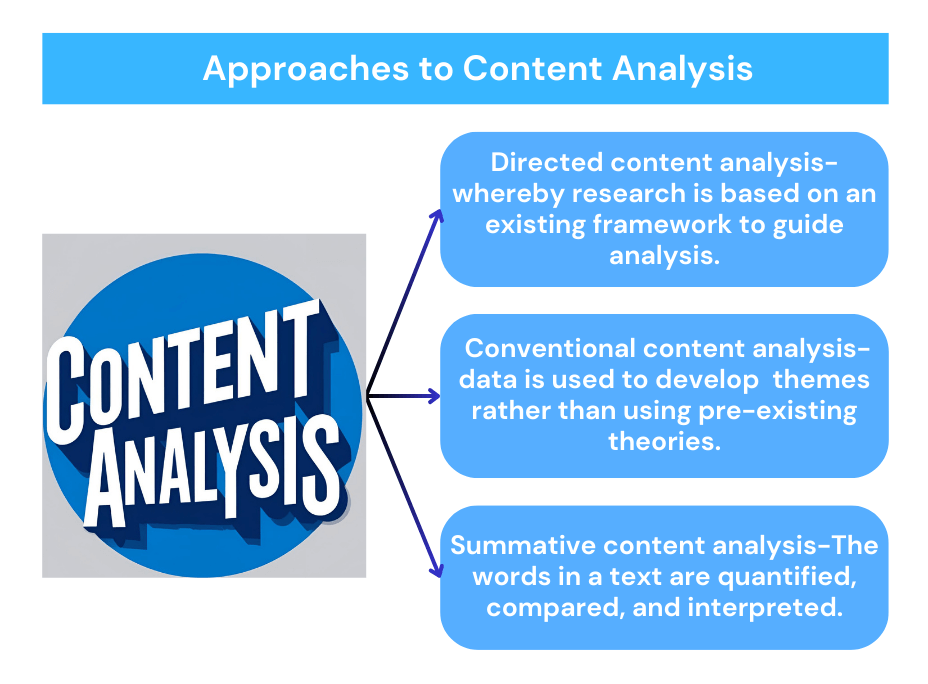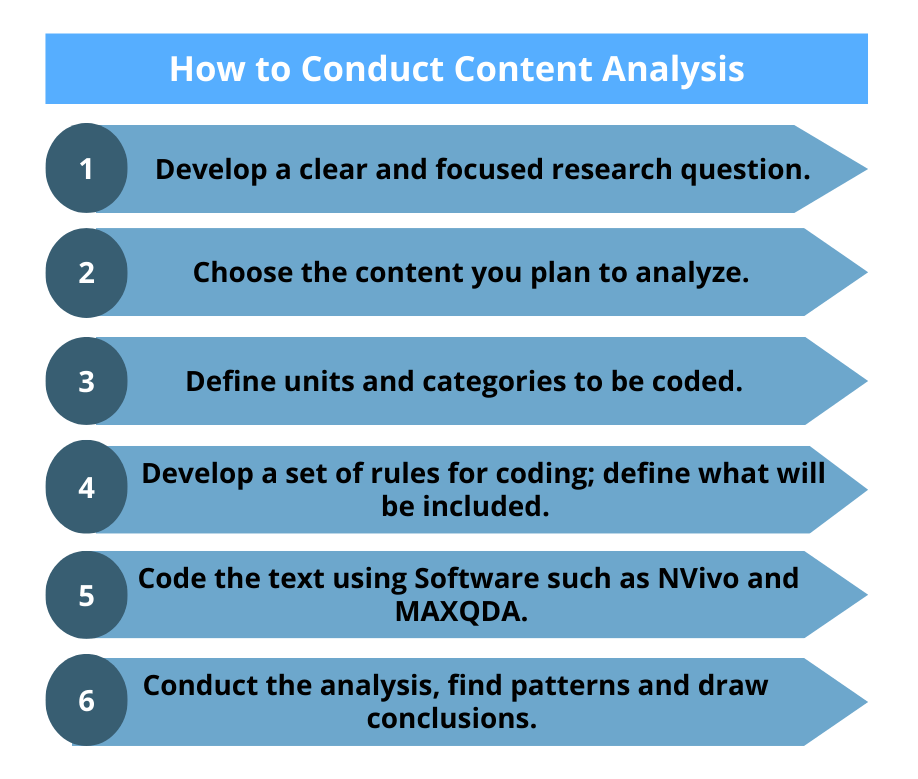Factors We Consider When Writing Content Analysis Qualitative Research
Effective content analysis qualitative research writing services assist scholars in identifying, quantifying, and analyzing the presence, meanings, and relationships of particular words, concepts, or themes within given data.
We have experienced content analysis research writers who carry out an extensive qualitative data analysis process on sources such as interviews, field notes, conversations, and any other relevant communicative documents. Relevant data can also be obtained from books, essays, historical documents, and newspapers among others depending on the research questions and objectives.
The qualitative content analysis process entails breaking text down into manageable code categories to summarize and make it more comprehensible. This article focuses on the various factors that we consider to offer the best content analysis research writing help to our clients.
What is Content Analysis in Qualitative Research?
The qualitative content analysis focuses on the understanding and interpretation of a particular text. The method can be used to determine particular word patterns within text or a set of written documents. Depending on the purpose of the qualitative research, we conduct inductive or deductive content analysis, observing three main phases of preparation, organization of data, and reporting of results.
The qualitative analysis process has been in use since the 1940s although it was limited to examining texts from different contexts and studies to determine the frequency of specific words or terms.
Today, the technological revolution has made it possible to use content analysis to analyze mental models in conjunction with the cognitive, cultural, linguistic, historical, and social significance of the text. Our content analysis qualitative research writing services are founded on careful consideration of the following factors.
1. The research question to be answered using the qualitative method
Before commencing the content analysis writing process, the research questions must be specified to provide the basis for the inquiry process and the relevance of the study. The research question(s) should be relatable with relevant theory and preconceptions for interpretation of emerging themes, patterns, and meanings.
2. Purpose of the content analysis qualitative research
It is imperative to understand the purpose of the content analysis qualitative studies and the objectives that the client wants to achieve. The purpose could be discovering the intentions, focus, or communication trends for an individual, group, or institution; describing attitudes and behavioral responses towards information, revealing patterns present in a text, or pre-testing and improving an intervention or survey before launching it, among others.
The purpose can also be to analyze interview transcripts and focus group questions to obtain quantifiable data for complementing quantitative studies. Understanding why content analysis is the best choice among the qualitative research methods for that particular study question defines the scope and style of writing.
3. Type of content analysis
We are proficient in different qualitative analytical techniques and types of content analyses including conceptual and relational analysis as discussed below. The type of content analysis depends on the nature of the research question and each can lead to different results, alternative interpretations, conclusions, and meanings.
(a). Conceptual content analysis
The conceptual analysis process in qualitative research involves selecting a concept and examining its presence and occurrence in the collected data. The chosen terms may be implicit or explicit, depending on the research purpose, questions, objectives, and the available types of data.
When writing conceptual content analysis in a qualitative study, we first define the research question and choose the type of data collected for examination. The raw data is taken through a coding process to reduce it into manageable categories.
Our conceptual analysis writing and coding process are further influenced by factors such as:
(i). The level of analysis required
We have to determine whether to analyze the collected data at the word, sense in terms, phrase, themes, or sentence levels. The extent of analysis depends on the nature of research question and objectives.
(ii). The number of concepts to code for
To stay on track on the number of concepts to be coded for using the research technique, we develop pre-defined or interactive categories. A decision must be made on whether to allow flexibility and addition of categories during the coding process or strictly comply with the pre-defined scheme.
(iii). Whether coding for frequency versus the existence of a concept
Based on the nature of the research question, one has to decide whether to code for the number of times a concept or term appears in a text or its existence within the collected data.
(iv). Conclusions and generalizability of findings
After data gathering, coding, and categorization processes are completed, one can draw conclusions, identify trends, and patterns as they appear from the concept categories. It is at this point where one determines whether to reassess the coding scheme, ignore, or reexamine unused and irrelevant text.
(b). Relational content analysis
The relational analysis process entails identifying the research questions and choosing the type of data to examine. Our content analysis research writers ensure the questions are specific and focused to avoid leaving the concepts open to alternative interpretations and can be summarized.
The text to use in the qualitative approach is selected carefully while maintaining a balance between availing enough information that can facilitate thorough analysis without limiting the findings and extensive data that can confuse or derail the coding process, thus, hindering the realization of worthwhile or meaningful results.
Depending on the research topic, we choose the type of relational analysis methods to use such as affect extraction, proximity analysis, or cognitive mapping.
(i). Affect extraction
This type of content analysis entails evaluating emotions that are explicit in the text. Affect extraction methodological articles can be used in evaluating the psychological or emotional state of the speaker or writer in the text.
The method can be effectively used in qualitative health research in advanced nursing studies to assess the mental, psychological, or emotional state of patients and individuals under different conditions and settings. Therefore, scholars wishing to hire someone to write content analysis research for their theses, dissertations, capstones, essays, and related student papers can contact us for the best services.
(ii). Proximity analysis
Proximity content analysis involves the evaluation of the co-occurrence of concepts explicit in a string of words. We create a matrix that helps in evaluating a group in interrelated co-occurring concepts with an aim of identifying overall meanings.
(iii). Cognitive mapping
Our content analysis research writers use cognitive mapping to develop a model of the overall meaning of the text that can be used in representing how concepts relate. The cognitive mapping analysis method can be used as a visualization approach for proximity and affect extraction analyses.
4. The qualitative content analysis approach
The qualitative content analysis can also be classified into inductive and deductive based on the overall purpose of the research. When hired to write inductive content analysis, we ensure that the organization phase provides information about open coding, creation of categories, and abstraction of collected data.
In deductive content analysis process, we develop categorization matrix after reviewing the data and code it for correspondence with the identified categories. The validity of the categorization matrix can be established by determining whether it adequately represents the concepts and covers all that was intended.
5. Types of data sources/materials/text for the qualitative content analysis
The type of data to be used in the content analysis is systematically collected from a set of oral, written, or visual texts. The sources can be books, magazines, newspaper headlines, interviews, speeches, photographs, films, web, content, and other relevant communicative documents. An accurate description is essential for the type of sources used in the analysis to maintain the objectivity of the process.
The categorization process for the words, themes, and concepts; and the analysis of the results depend on the type of materials or data sources selected for the study. We choose the data collection method, the inclusion criteria, and other specific parameters such as date ranges or locations relevant to the content analysis qualitative research method.
6. Qualitative data analysis and collection methods
Clear methodological procedures for data collection and analysis are defined in our content analysis qualitative research writing services. We also provide justification for not choosing any other research method such as quantitative content analysis, focus groups, ethnography, or grounded theory coding process. The type of tools used in the qualitative content analysis must be explained, and whether pilot testing was carried out before using them in the research.
The choice of data collection method affects the extent of analysis that can be conducted in the text. The qualitative content analysis research process can be cyclic owing to the possibilities for changing the instruments/tools or questions. However, when the same data is used, similar rigor must be transferred to the new research question/instrument as the initial ones.
7. Content analysis process and presentation of findings
After processing both qualitative and quantitative research, it is necessary to present the findings of the study to a specific audience who may be professional or academic. The results of the content analysis qualitative study are presented in a specific manner to answer the research question(s), find patterns, and support the overall purpose of the inquiry. One should be able to make sense of the themes, categories, and patterns identified along with their properties.
With the help of effective content analysis qualitative research writing services from experts, one can draw credible conclusions from the collected data. We achieve this through activities such as exploring the dimensions and features of categories, identifying relationships, and uncovering patterns.
8. Discussion of the findings with respect to objectivity and trustworthiness
The objectivity of the qualitative content analysis results can be ascertained by assessing the extent to which the findings are independent of the researcher. Because of the possibility of coding errors, it is fundamental to evaluate the reliability and validity of content analysis qualitative research before submitting the report to the target audiences.
Our content analysis research writers use the following criteria to assess the reliability of the process.
(a). Stability
For a content analysis to be stable, the coders must consistently re-code the same data in a similar manner over a period of time.
(b). Accuracy
To assess the accuracy of the process, we consider the extent to which categorization of text conforms or corresponds to a standard/norm in statistical analysis.
(c). Reproducibility
The reproducibility criterion in evaluating the reliability of content analysis can be ascertained if a given group of coders can classify category membership in a similar manner.
The validity criteria of a content analysis comprise the closeness of categories, conclusions, and the allowable levels of implication, and generalizability of the results to a theory. Throughout the writing process, we adhere to the researcher's qualitative perspective to attain rigor and credibility, thus, making the results trustworthy.
Regardless of the chosen data collection method, the best content analysis research writing help from experts assist in reducing the volume of the text, identifying, and grouping categories together while seeking to understand emerging themes, patterns, or meanings.
9. Reporting of findings
After analyzing the collected data, the files are organized into a format that can be understood by the target audience. We, therefore, review the final results of the content analysis qualitative research, identify patterns, sequence, and present the information in the form of a report, whose format depends on the nature of the receiving audience.
No matter the type of format that we adopt for the report, our writers ensure the common sections are clearly presented, each with the relevant information as it pertains to the purpose of the research. The basic structural elements of the content analysis qualitative research comprise:
(a). The introduction
The introduction section of the report contains all the basic information pertaining to the inquiry such as the date, aims, objectives, and the location chosen for the study.
In addition, we provide an explanation and justification for any tools and instruments that may have been used in the research, selected data sources and their composition. The rationale for the study and justification of the content analysis methods in qualitative research are also provided with regard to the study questions and objectives.
(b). Methodology
The methodology section of a content analysis qualitative study contains complete and truthful information about the procedures and processes to facilitate replication of the research. We report on the practices and decisions made in the coding process, categorization, and all the strategies used to establish the trustworthiness of the study.
(c). The findings section
The findings section is presented with utmost clarity for the reader to comprehend and interpret the report. In this section, we offer detailed analysis information, the observations made during the study, and important findings. The findings include patterns, themes, and categories of significance in real-world situations.
Where applicable, we incorporate visual displays such as graphs, diagrams, matrices, and charts while ensuring a balance between the description and interpretation of findings. Other components of the report such as conclusions, recommendations, limitations and strengths of the study; references, appendices, bibliography, and supplemental materials are included depending on the nature and format of the report required by the client.
The form and extent of reporting the content analysis qualitative study findings depend on the specific goals of the research. With the best content analysis research writing help from experts, clients are assured of an interesting and readable report from which the audience can completely understand the basis for interpretation of a phenomenon.
Our writing services ensure enhanced clarity and conciseness, flow and continuity, excellent grammar and usage, and strict compliance with all rules of mechanics of style in every assignment, hence, clients are assured of the best quality papers.
Scholars who may be unable to complete their content analysis qualitative research papers and other assignments should consider investing in our writing services. One can purchase content analysis qualitative research from us and rest assured of trustworthy work that is credible, transferable, confirmable, and dependable. We are readily available on our live chat and accessible 24/7, with excellent customer support services and favorable prices. Contact us today and get to enjoy our exceptional qualitative data analysis services.








